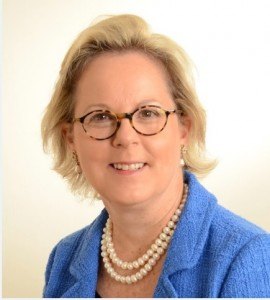(This article is based on a speech delivered by Erin Hamrick on June 20, 2016, as she accepted the APIW Insurance Woman of the Year award in New York City.)
In reflecting on this honor and writing these remarks over and over, I thought about the influences in my life, the platform that I created with Sterling James, and about women and leadership in insurance.
Executive Summary
Erin Hamrick, APIW’s Insurance Woman of the Year for 2016, reflects on how work in the military and playing golf have influenced her career and offers a modest proposal for insurers to consider in moving toward a goal of recruiting more women to the industry and ultimately moving them into positions of leadership.In the words of Winston Churchill, “A pessimist sees the difficulty in every opportunity; an optimist sees the opportunity in every difficulty.” So yes, if you know me well, I’m the optimist. And I think I have a great idea for the industry. Although it is a big “ask,” I really don’t think it is difficult.
What I do know is that I have an idea for something concrete that will further the cause in promoting women in leadership in the industry.
Walking Among Leaders
When I think of leadership, there is no better training ground than the military. My experience of working with the military was an absolute privilege. Unless you have worked in the military or have had an experience like I had working at the Department of Defense, I don’t know that you can fully appreciate the military’s ability to train and develop leaders.
It was humbling being in the presence of those who have spent their entire careers leading—all to protect our freedom and the freedom of others. It is why I am so proud that Sterling James’ first ongoing charity commitment was to the Wounded Warrior project.
In truth, that DOD experience was a bit harrowing at times—and that is being polite. But I do distinctly recall one particularly contentious discussion with someone whose name I cannot share. Suffice to say we were really going at it toe-to-toe, in front of others. And I would not stand down, so to speak.
Actually, it was easy because I was right and he wasn’t, but that is beside the point. We’re walking out of the room when this colonel turned to me and said, “You are unflappable, Erin, and totally not intimidated by these guys!”
And they were all guys—no women at all.

I remember my response. I told him I played golf on the Boys’ Varsity team in high school. I had my bag dumped out on the first tee; several boys refused to play against a girl. They made all sorts of rude, loud and inappropriate noises through my backswing. You name it, these boys did it.
The Power of Golf
So going back to thinking about influences in my early years, it dawned on me that I might not be here today without having played golf in high school. That’s the foundation that gave me the perseverance, self-esteem and patience to build my career.
Additionally, I feel golf gave me the self-confidence to take the leave of absence and work at the DOD. This then led to me having the fortitude to start Sterling James.
(Editor’s Note: In 2000, when Erin was working at the Wall Street office of recruiting firm Heidrick & Struggles, she witnessed the events of Sep. 11, 2001. She asked to join the Department of Defense to help assist with the reconstruction of Iraq, taking a leave of absence from insurance employment recruiting.)
Three years ago, I started playing golf again, after not playing for 20 years. I did so in the middle of my radiation therapy for breast cancer. Golf again provided me with the physical and mental therapy that I needed. And yes, I’m proud to say that I haven’t broken 80 yet, but I broke 40 twice, so I know I’m close to being back.
By now, you are probably thinking, “Where the heck is she going with all of this?”
What Else Does Golf Have to Do With Women in Leadership?
As luck would have it, my two passions—golf and women in leadership—collided last year, and that prompted my idea on something that leaders in the property/casualty industry could do as a definitive and tangible step to show their commitment to supporting future women leaders in the industry.
But before I tell you what happened and my idea, let’s engage in a little Q&A:
Q: 33 yards
A: The difference in average drive between PGA and LPGA players.
Q: $50 million vs. $6 million
A: The difference between Jordan Speith and Stacy Lewis in 2015 earnings. Prize money difference was $23 million vs. $1.8 million.
Q: What do Farmers, Zurich, Travelers, Chubb and Nationwide all have in common?
A: All sponsor PGA golf events.
Q: What percentage of female executives played high school or college sports?
A: 82 percent (according to a 2002 survey conducted by OppenheimerFunds and the MassMutual Financial Group, “From the Locker Room to the Boardroom: A Survey on Sports in the Lives of Women Business Executives.”)
Now, I’m hoping some of you might start connecting the dots here, but don’t worry, I’ll be very direct in a minute.
So, what happened last year when passion for golf intersected with women in leadership? Girls Golf! My friend Sharon Ritchie, who some of you might know as chief operating officer of AXA U.S. and an LPGA Board Foundation member, invited me to play in the LPGA Girls Golf Pro-Am.
What is Girls Golf? Supported by the LPGA, it is an all-girl environment to learn the game. Last year, 60,000 girls ages six to 17 participated in their program.
And what does it teach beyond a good swing? Self-confidence, perseverance, self-reliance, discipline and self-esteem.
The event was sponsored by AXA and was just outstanding. But it did cause me to research what the P/C industry was doing to support the LPGA. I think by now you know the answer.

“I might not be here today without having played golf in high school. That’s the foundation that gave me the perseverance, self-esteem and patience to build my career.”
Erin Hamrick
Zero!
How can this be? Have you ever tried to talk to an insurance executive on a Friday afternoon in the summer? Where are they? Playing golf.
So, on one hand, golf is what insurance people do. On the other, we have more and more insurance women’s leadership conferences to discuss the same topic—what to do to get more women into the C-suite and onto boards of P/C insurance companies—that result in no tangible outcomes.
And then low and behold, here is the LPGA with a pipeline of talent—60,000 girls to be exact—and really the next generation of women leaders.
And just when I’m working on my comments for this speech, KPMG clearly recognized what I recognized: a great opportunity. In the event you missed it, KPMG announced on June 7 that proceeds from both their PGA and LPGA events would go toward facilitating a leadership and scholarship program at Stanford University for 16 young women, with the support and endorsement of former Secretary Condoleezza Rice.
So, as most of you who know me know, my favorite saying is: “You don’t ask, you don’t get.”
Here is my ask: The P/C industry is missing an opportunity to be involved with the LPGA in some form or fashion. Support a player, support a tournament, host a Girls Golf LPGA Pro-AM, or do something unique like KPMG.
And just so you have some context of how much money we are talking about:
- The 2016 PGA tour purse is $320 million for 47 events.
- The LPGA purse is $65 million for 34 events.
Doing the math, that’s $7 million per event vs. $2 million.
This is not a big monetary ask relative to what some companies are already doing.
I also have a list of all the LPGA sponsors with names I’ve never heard of. How very sad that no one in this room is on this list.
For an industry that so desperately wants to see more women in leadership roles, currently supports so many PGA events and professionals, and has so many executives that love to play golf, I think this is a cause worth pursuing. I’m going to be pushing it hard, and I’m asking for your help.
Reflecting on Churchill’s quote: I’m know I am an optimist, but can this really be that difficult?
Quite simply, the leaders in this industry can do something they love to do—all the while getting credit for promoting a cause they claim is at the top of their agenda.




















 Study Urges Rethinking of Disaster Management in Era of Compounding Events
Study Urges Rethinking of Disaster Management in Era of Compounding Events  Report: Insurers Keen on Replacing Legacy Systems Seek More Agility
Report: Insurers Keen on Replacing Legacy Systems Seek More Agility  Middle Manager Is the Middle Child
Middle Manager Is the Middle Child  What Role Does Insurance Play in a Politically Charged Climate?
What Role Does Insurance Play in a Politically Charged Climate? 










